In the first encounter of Liverpool and RB Salzburg at Anfield back in October, the home side managed to score three goals in 36 minutes. Amazingly, Salzburg equalised the scoreline in just 25 minutes, with young sensation Erling Braut Håland’s scoring their third goal. Nine minutes later, Mohamed Salah scored past Cican Stanković to guarantee the win for Liverpool.
Two months later, both sides meet once again, now at the Red Bull Arena. This time Salzburg needed a win to give them a chance going to the knockout stage. In the other side, Liverpool just needed a draw to advance to the next round of this season’s UEFA Champions League. A seven-goal thriller in their first meeting boosted the hype even further.
At the end of the night, Liverpool managed a convincing away win and reached the knockout stage as the Group E leader. Clever tactics deployed by Jürgen Klopp was the secret behind The Reds’ 0–2 victory. In the other side, Jesse Marsch was unable to respond to Klopp’s tactical adjustments, especially in the second half – therefore giving Salzburg a ticket to the Europa League. This tactical analysis will inform how the match unfolded.
Lineups
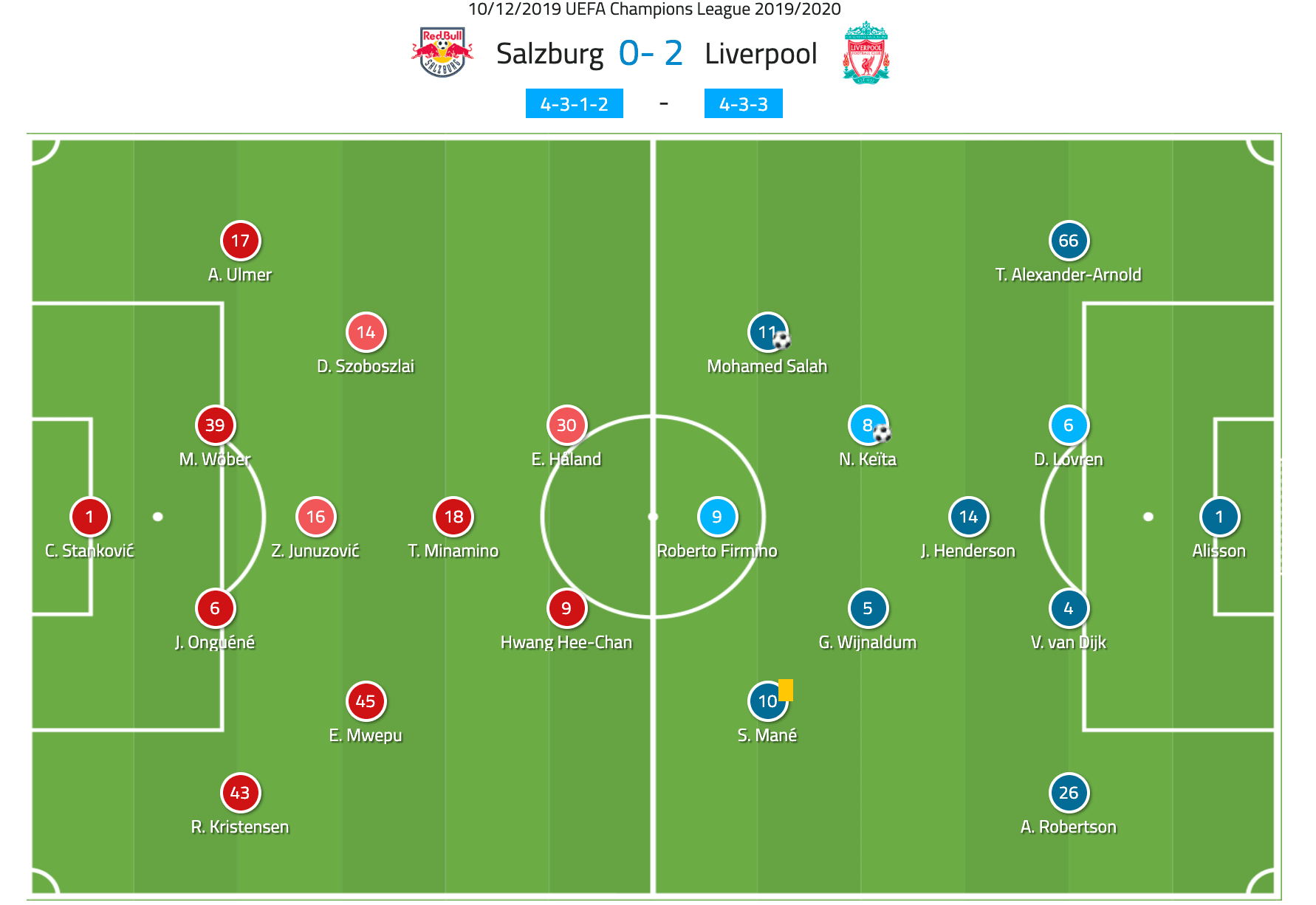
On paper, Marsch chose 4–3–1–2 for his team, which slightly changed to a 4–1–3–2 on the field. Jérôme Onguéné and Maximilian Wöber started in the heart of the defence while Zlatko Junuzović provided defensive support in front of them. Japanese Takumi Minamino played as an attacking midfielder just behind the duo of Håland and Hwang Hee-chan. The dugout was filled with youngsters like Majeed Ashimeru, Patson Daka, and Masaya Okugawa.
In the other side, Klopp picked the usual 4–3–3 for his men. Captain Jordan Henderson was chosen to fill in Fabinho’s position due to the Brazilian’s injury; flanked by Georginio Wijnaldum and former Salzburg player Naby Keïta. The deadly trio of Salah, Roberto Firmino, and Sadio Mané led Liverpool’s frontline. Names like James Milner, Joe Gomez, and Divock Origi had to start the game from the bench.
Salzburg’s smart defending
Since the first minute, Salzburg showed discipline and aggression in their defensive display. Against Liverpool’s build-ups, the main focus of Salzburg’s defensive tactics was to close nearby passing options for the on-ball Liverpool player. After that, one Salzburg attacker would press the on-ball opponent, but still keeping an eye to his man via his cover shadow. This approach’s objective was to force Liverpool to play direct balls, which were not so effective.
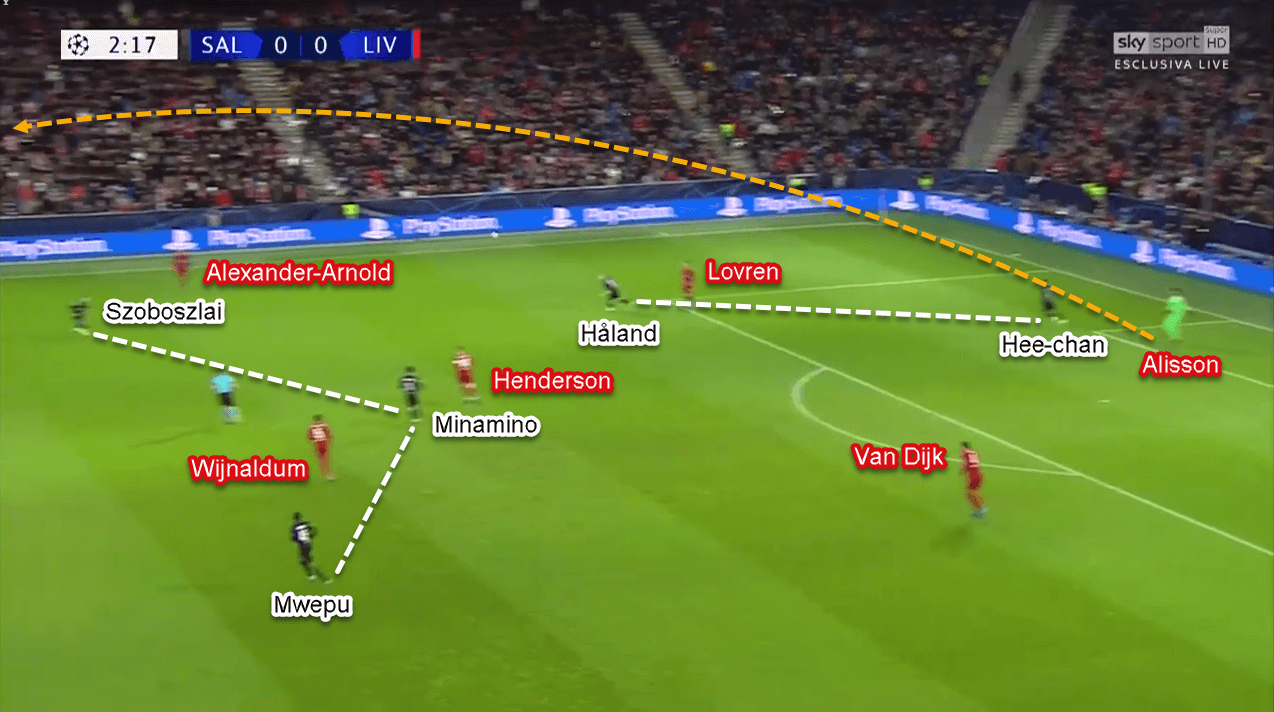
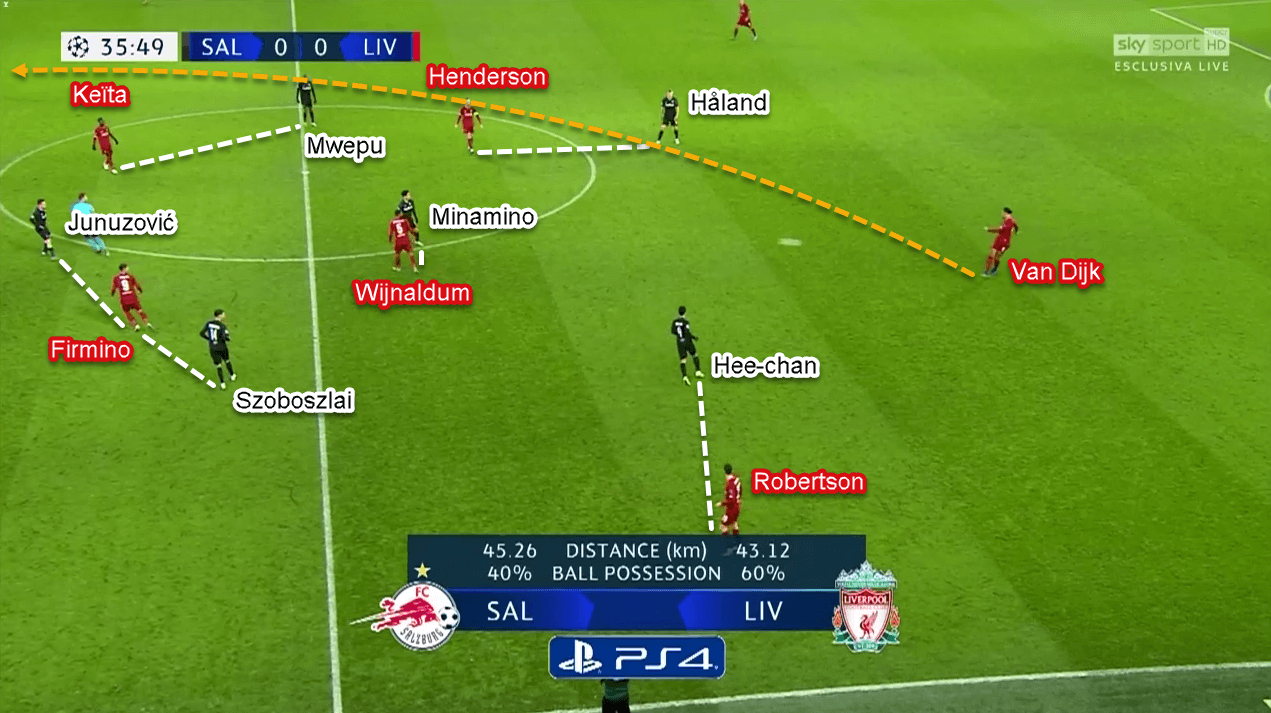
Deeper in their mid-block 4–1–3–2, Die Mozartstädter flooded players centrally. In total, there would be six players defending from one half-space to the other, compared to Liverpool’s maximum of three midfielders. By focusing to defend the central spaces, Salzburg forced Liverpool to build their attacks from the wide areas.
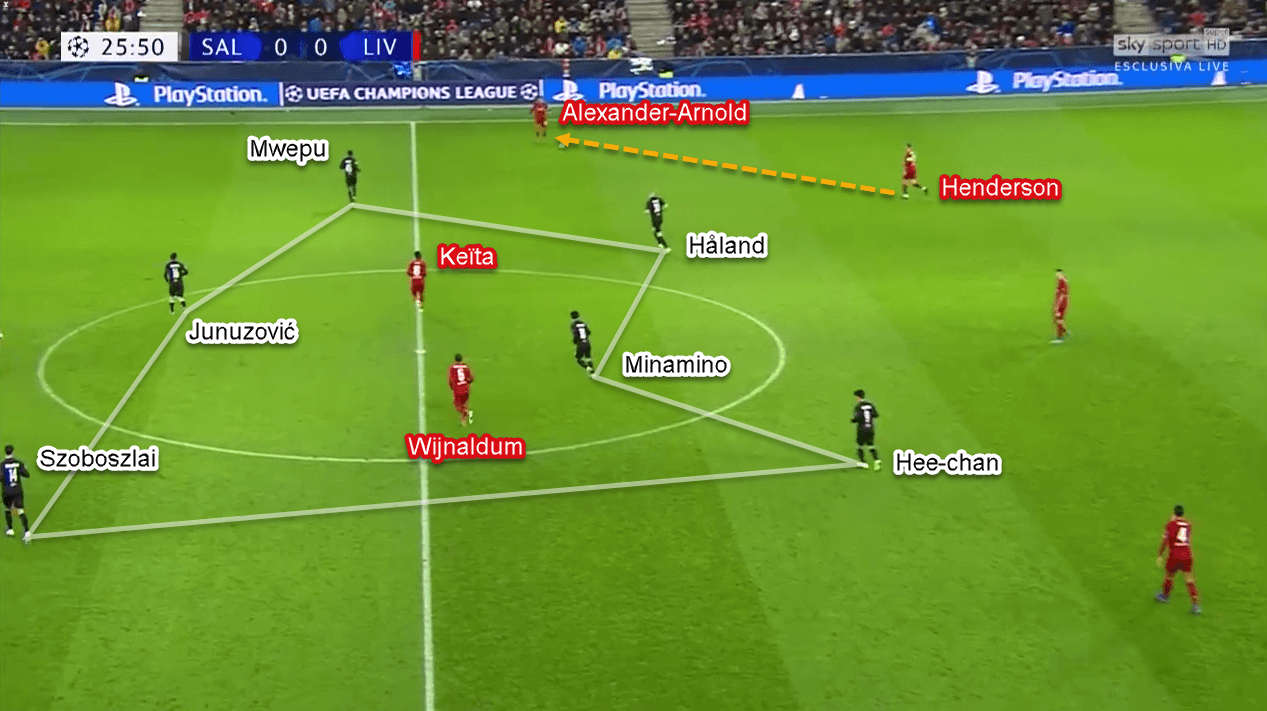
Salzburg were also famous for their aggressive pressing game, which came into display in this match. There were two triggers of this pressing: first, just after they lost the ball; second, when Liverpool were forced to play wider. They executed the (counter)press by focusing heavily on the ball and abandon the ball-far side. Salzburg would crowd the on-ball player, and also close nearby passing options aggressively before trying to steal the ball. The objective of this approach was to win the ball quickly and allow many combinations to initiate the counter-attacks.
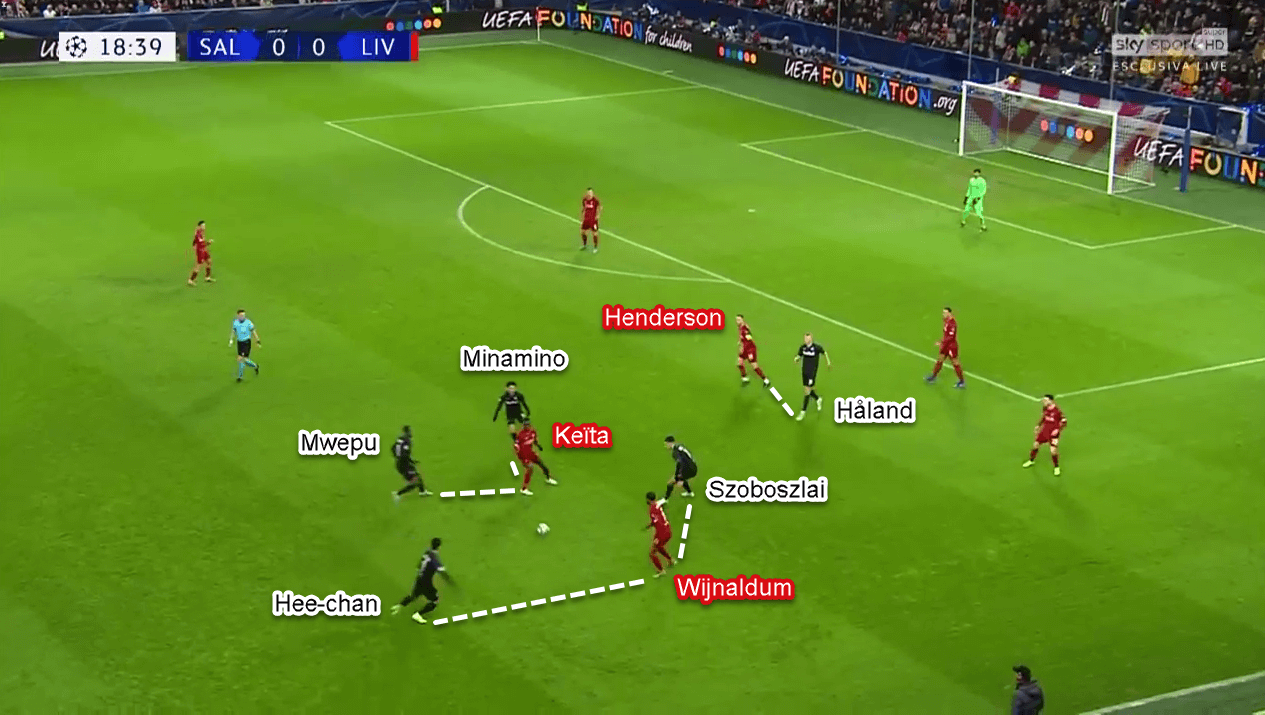
Salzburg nullified (minimum) threats in the flanks
In this part of the analysis, we are going to see how Salzburg prevented Liverpool from exploiting the wide areas. First of all, an issue Liverpool had in their 4–3–3 was not having enough players in both flanks. With the wingers tucking inside and the outside central midfielders playing in the half-spaces, practically only the full-backs had the responsibility to provide the width.
Not only that, but both Salah and Mané rarely dropped or drifted wide to help the build-ups. Instead, they would rather wait in between the lines or pin themselves to the home side’s backline.
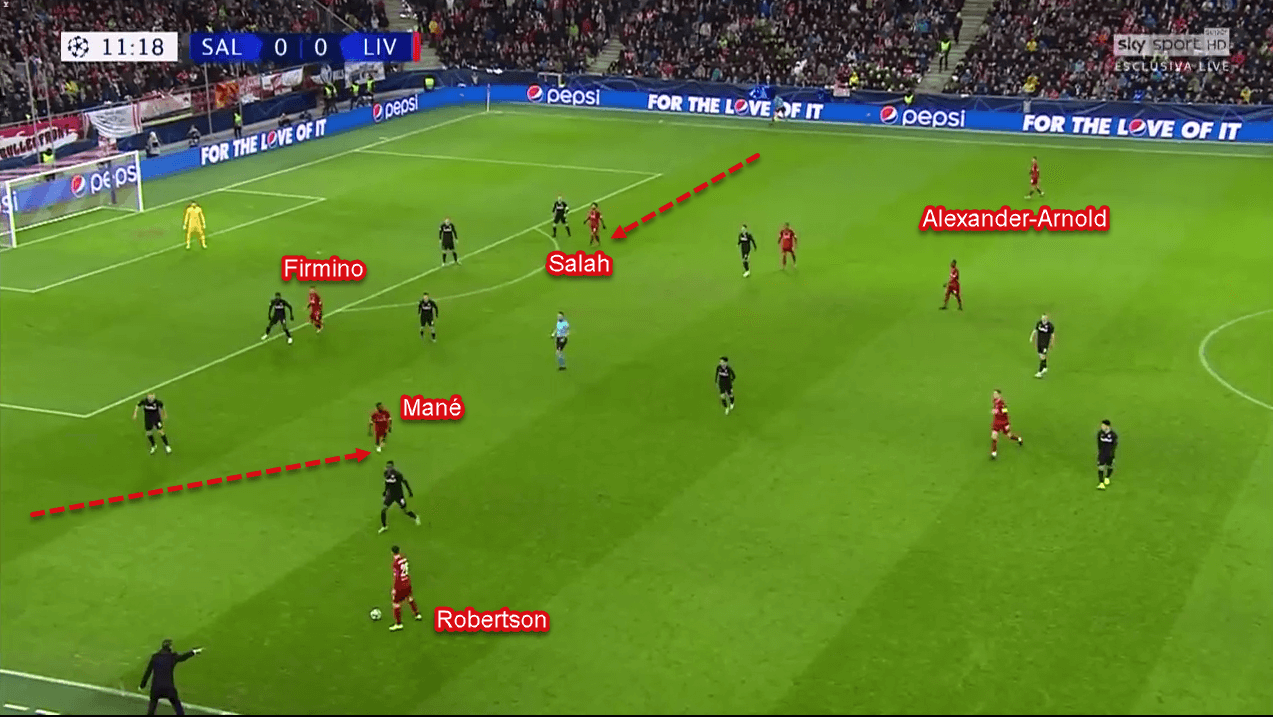
The issue loomed large when Liverpool tried to build their play from the flanks. Either Dominik Szoboszlai or Enock Mwepu — Salzburg’s outside midfielders — would come out to press Trent Alexander-Arnold or Andrew Robertson when they got the ball. Had Keita or Wijnaldum came to offer help, Salzburg’s nearest full-back would follow the midfielder and prevent the ball to be played short. Again, Liverpool were forced to play long balls which were not effective due to their attackers’ lack of size.
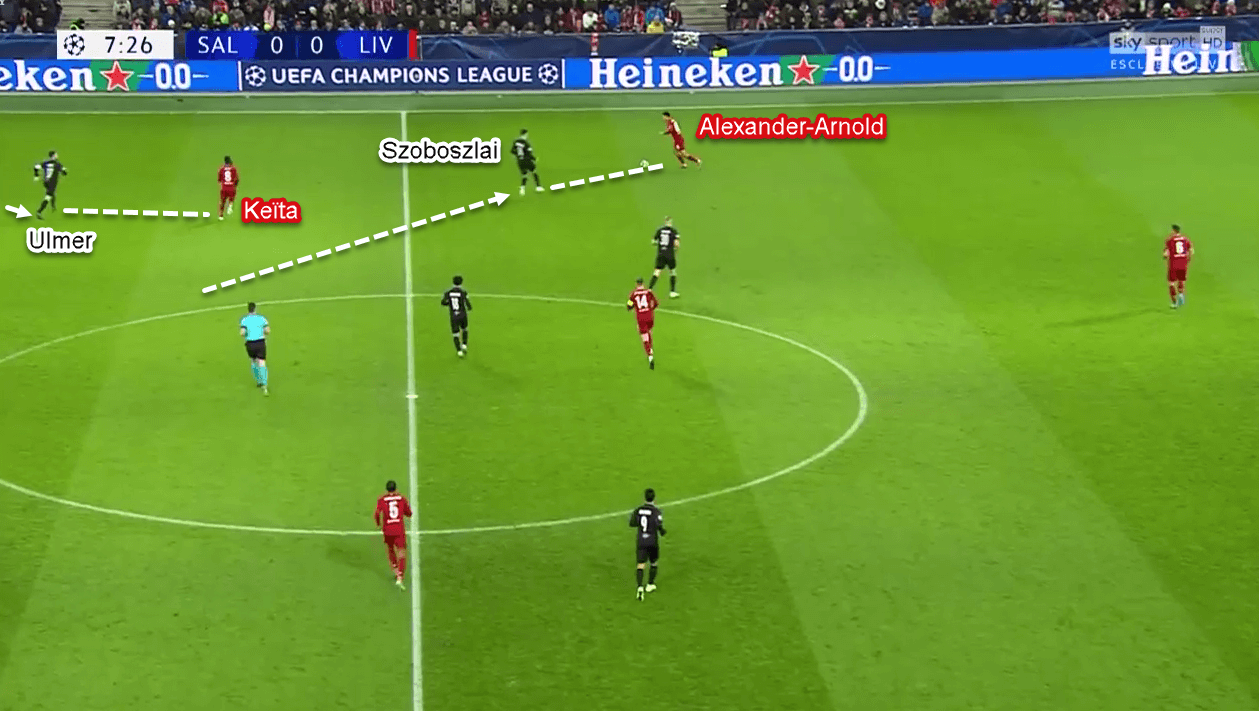
Liverpool escaped Salzburg’s pressure (part one)
As mentioned before, Salzburg’s pressing game was mainly ball-focused. This means Salzburg would flood players around the ball and abandon the ball-far side completely. Liverpool showed their worth by exploiting this particular defending issue many times in the game, and with many creative ways.
First, Liverpool would use a very-quick combination before making a switch to the ball-far side. Knowing that they only had minimum space and time to make combinations due to Salzburg’s aggressive press, The Reds only used maximum three touches before making a diagonal pass to the ball-far side. In the far side, the full-back would come a bit inside to receive the switch. This approach was mainly used when Salzburg tried to steal the ball from throw-in situations.
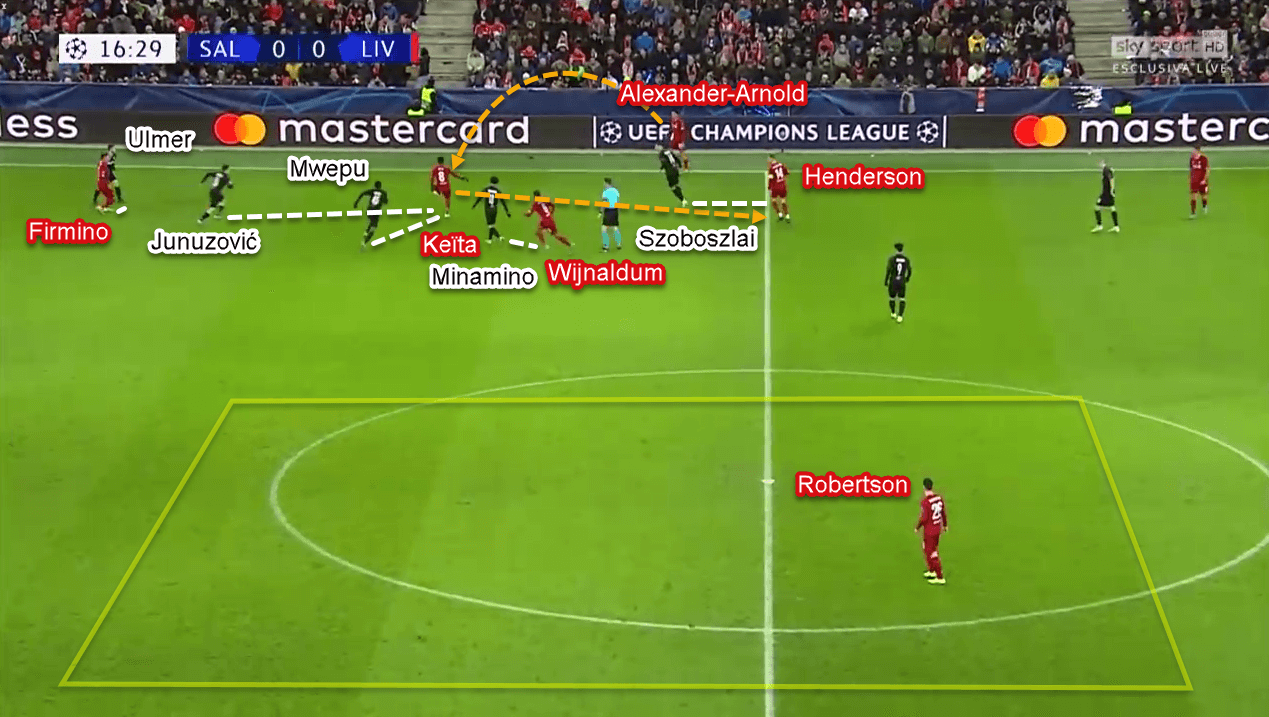
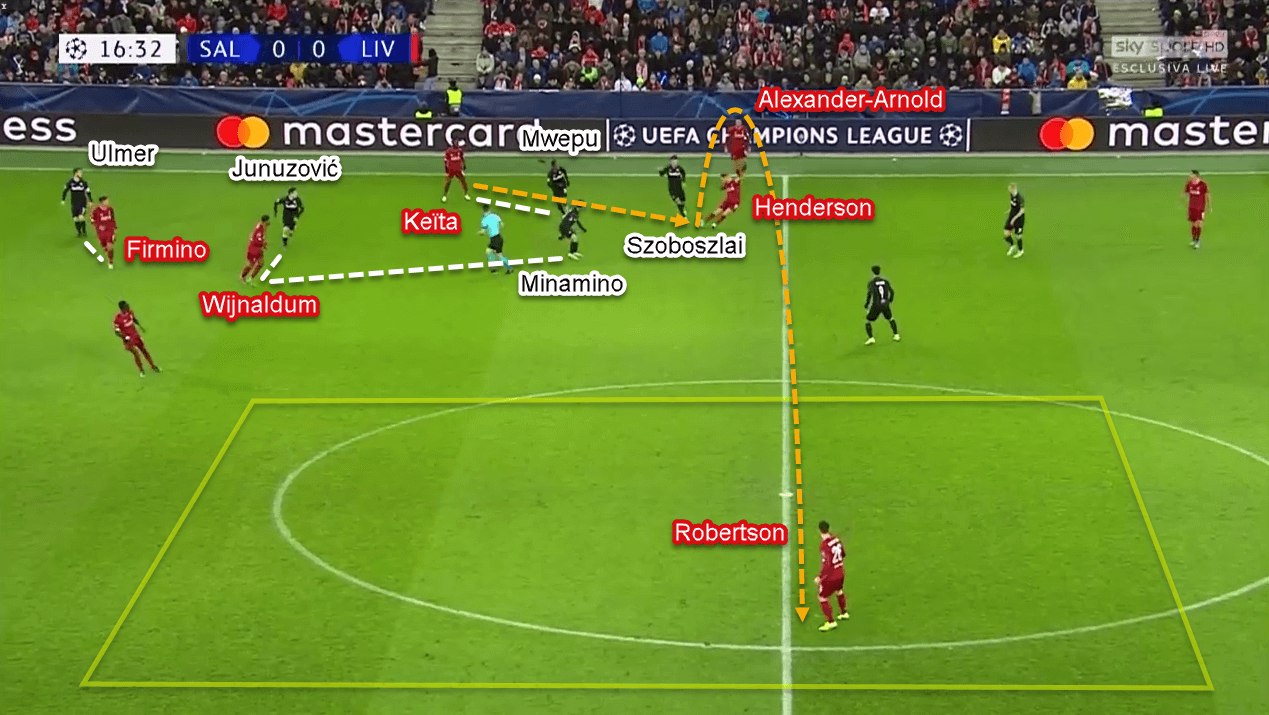
Liverpool escaped Salzburg’s pressure (part two)
Another way Liverpool exploited Salzburg’s pressure was by using their needle players: those who have good on-ball skills and supreme ability in tight spaces. Those characteristics would allow them to find a way out of Salzburg’s aggressive pressing quite easily. Lucky for the away side, in this game they had many players with those abilities: ranging from Wijnaldum, Mané, Firmino, to Keïta.
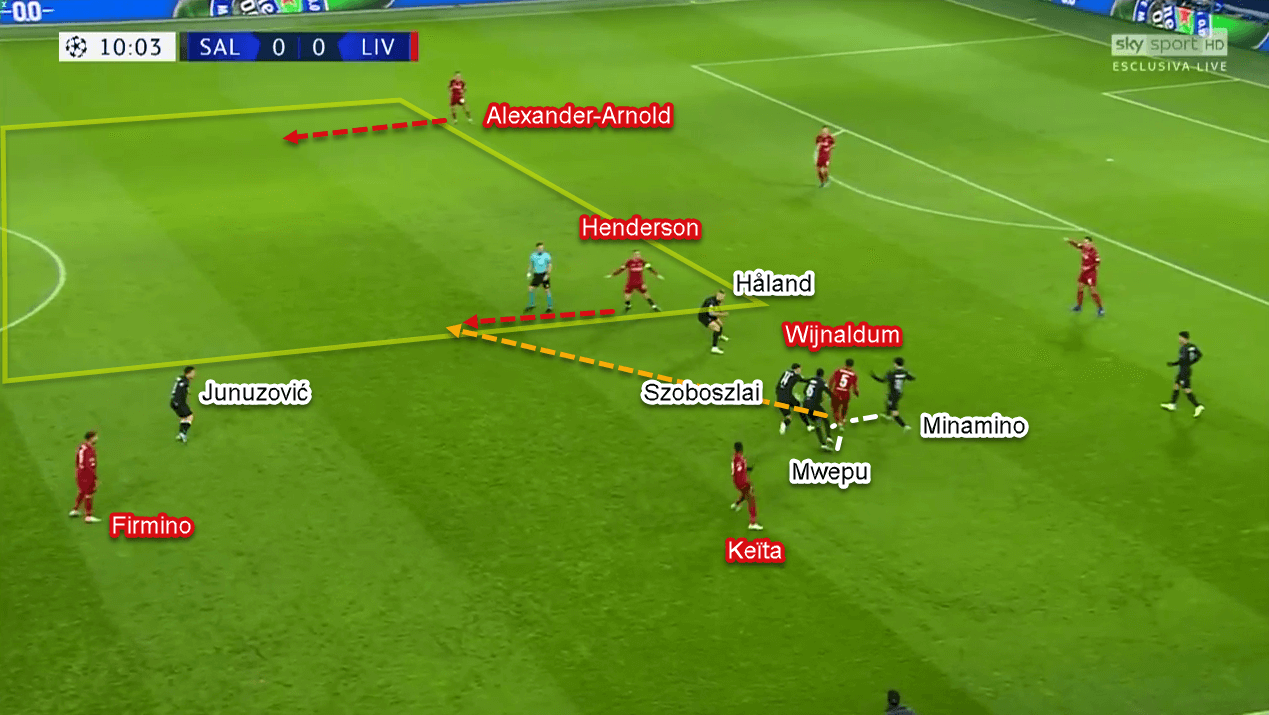
To make their combination plays smoother, sometimes Firmino would drop to the left-side half-space to help Wijnaldum and/or Mané. Even though his movement would pull another defender with him, the Brazilian’s quality in tight spaces still gave more benefits than losses for Liverpool.
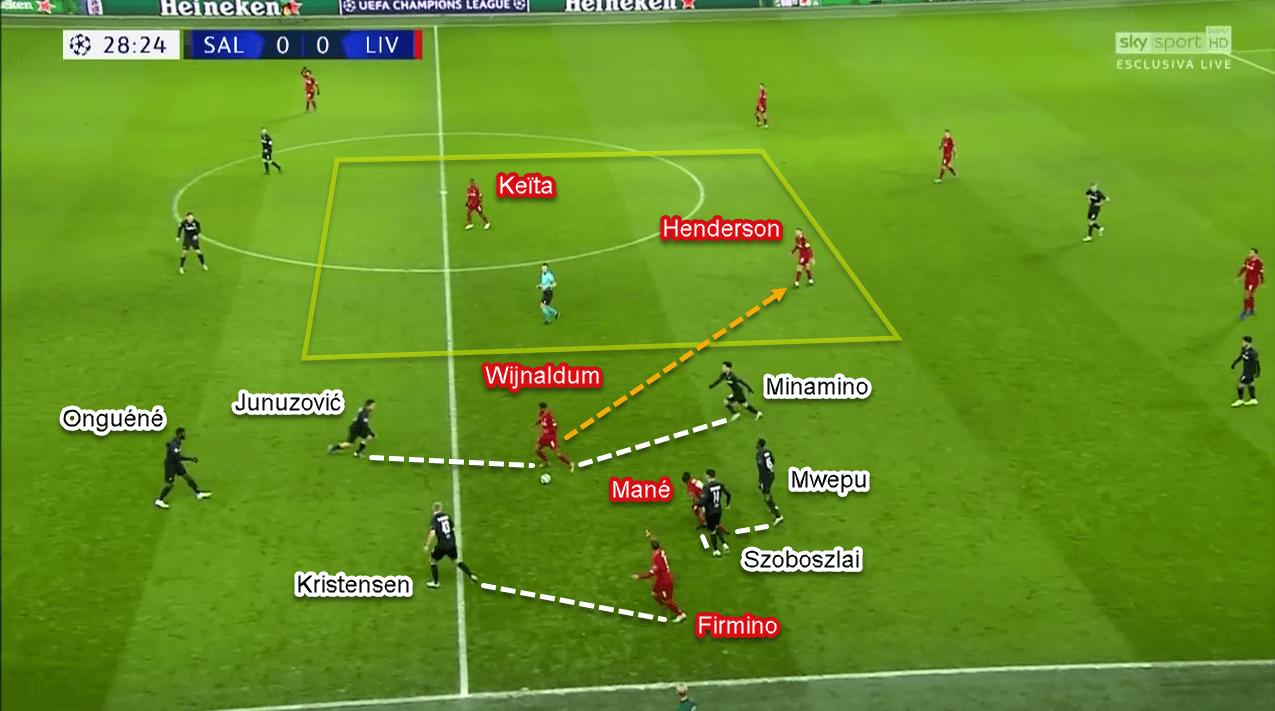
The main objective of locating the teammate(s) in the ball-far side was to give Liverpool time and space to make their rapid counter-attacks. With up to two players in such space, they could bring the ball forward without any disruption. After that, either Keïta, Henderson, or Alexander-Arnold could find Salah more easily – a sight Salzburg’s defenders didn’t want to see.
Liverpool’s ability to escape from Salzburg’s midfield pressing game damaged the home side even further. An unsuccessful pressing effort and a shift across the pitch would reduce their stamina, let alone multiple failed attempts. Salzburg’s pressing game turned into a game of chasing shadows, resulting in a heavily decreased intensity in the second half.
The Red Wall
It wasn’t just the home side but Liverpool too, showed some interesting defensive tactics. In this game, Klopp tasked his team to defend in a mid-block 4–3–3. Furthermore, the German manager rarely instructed his players to press as aggressive as they usually do.
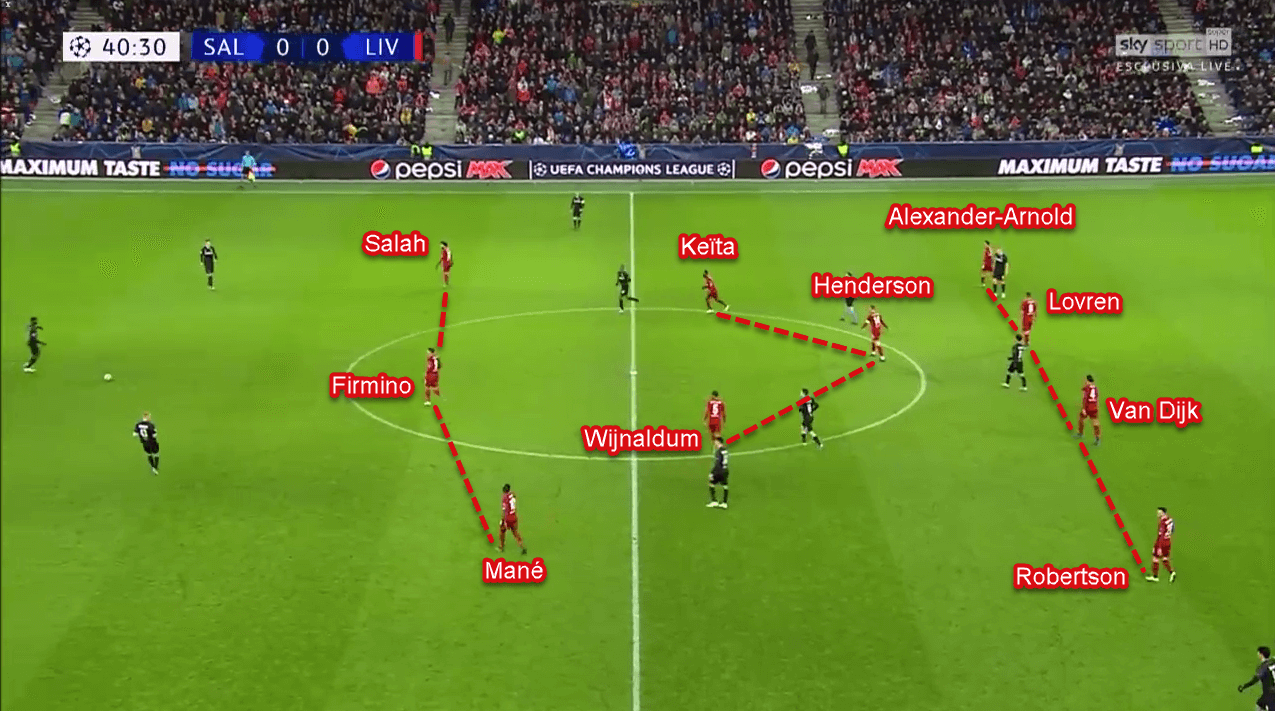
In the 4–3–3, Liverpool were so compact vertically. It meant they didn’t allow a lot of space in between the lines thus preventing Salzburg’s attackers to roam there freely. On top of that, they also installed a high defensive line with offside traps as their additional defensive weapon.
Against Liverpool’s high defensive line, Salzburg utilised more direct balls to exploit the space in behind. The provider was mainly the defender, as they weren’t pressured heavily by Liverpool’s frontmen. Up front, Håland was the usual target, not only because of his size but also his speed. However, this approach didn’t bear a lot of fruit since Liverpool’s backline’s discipline to deploy the offside trap.
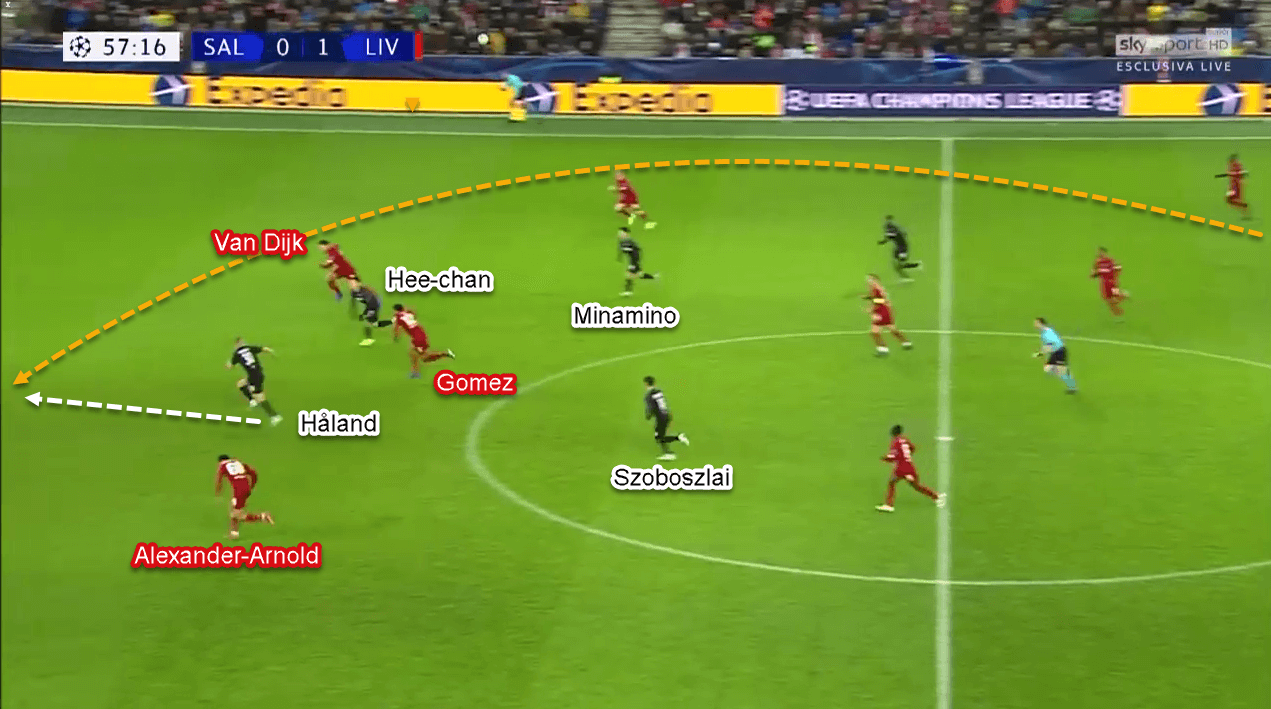
Despite the huge risk of a high defensive line, Liverpool are very discipline in deploying their offside traps.
Salzburg managed to create some chaos, but not enough
However, Salzburg did manage to make some damage to Liverpool’s backline; particularly when Liverpool gave up space in between the lines or when they lost the ball in their attacks. Salzburg targeted the left-hand side because Keïta, Alexander-Arnold, and Dejan Lovren were considered weaker defensively than their teammates in the opposite area. On top of that, Salzburg put their talisman Håland on the left side so they could feed him more easily.
To start their attacks, Salzburg opted to flood players in one area to allow combinations easier to make. After that, they would go forward as a unit and attack quickly, rather than possessing the ball for a long time. Approaching the final third, the attacking group would stay narrow to keep the combination routes available. Then, at least one of the forwards would offer runs in behind to disrupt the defensive line.
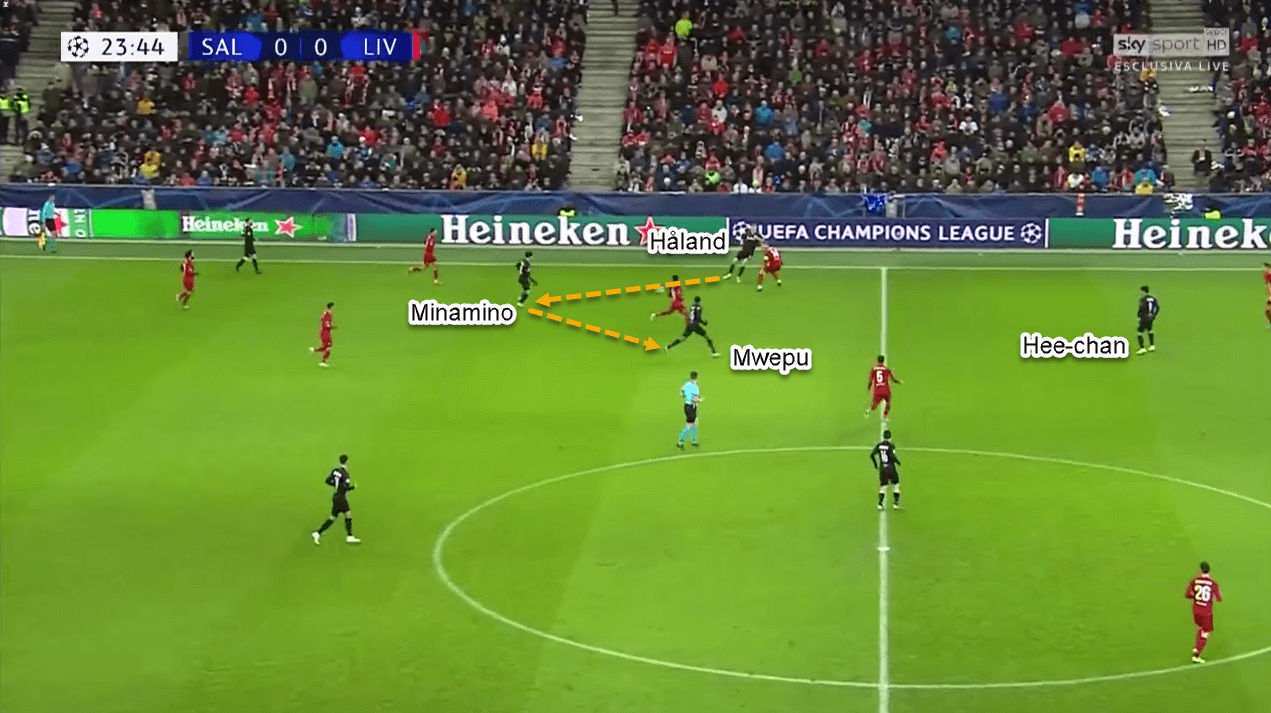
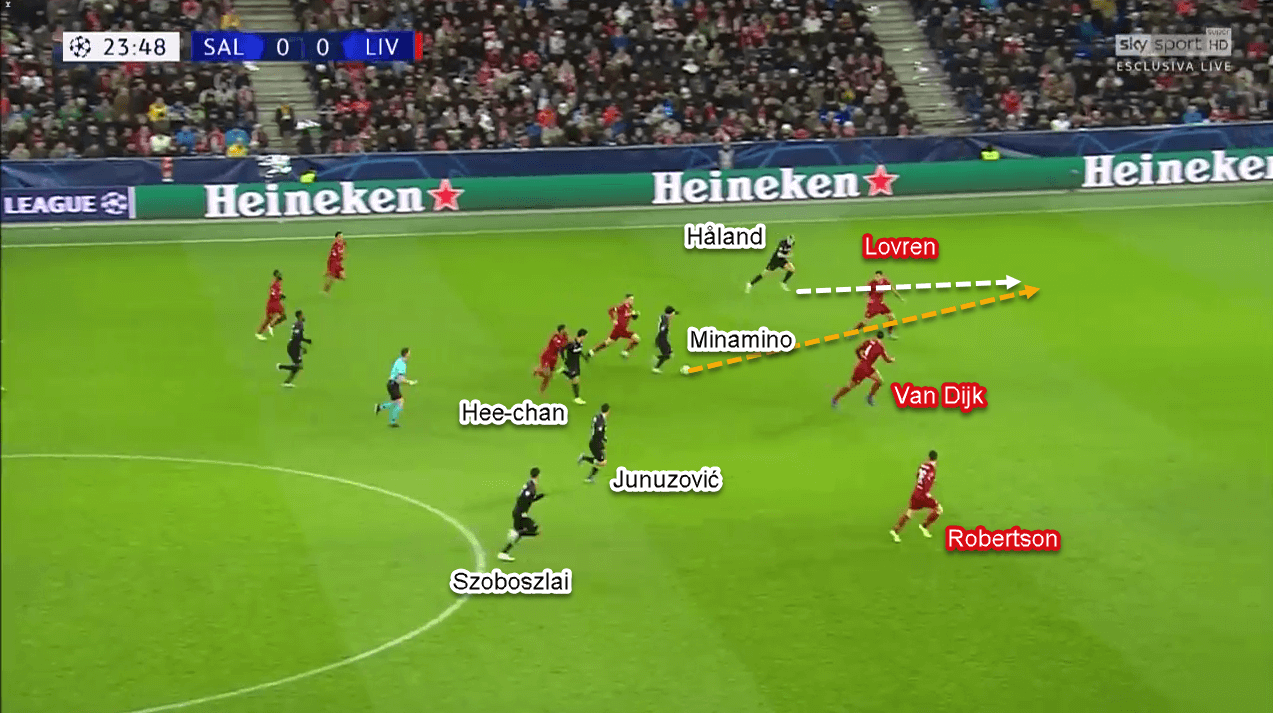
This left-side-focused ‘blitzkrieg’ approach did give them some scoring chances, however, their talisman Håland couldn’t maximise those opportunities.
Klopp’s tactical adjustments
Liverpool changed their attacking approach in the second half. Knowing that Salzburg’s midfield would decrease their pressing intensity after chasing shadows in the first half, Klopp then made some adjustments. Going to the second half, Klopp shifted his team shape to a 4–2–3–1 and tasked them to play more direct.
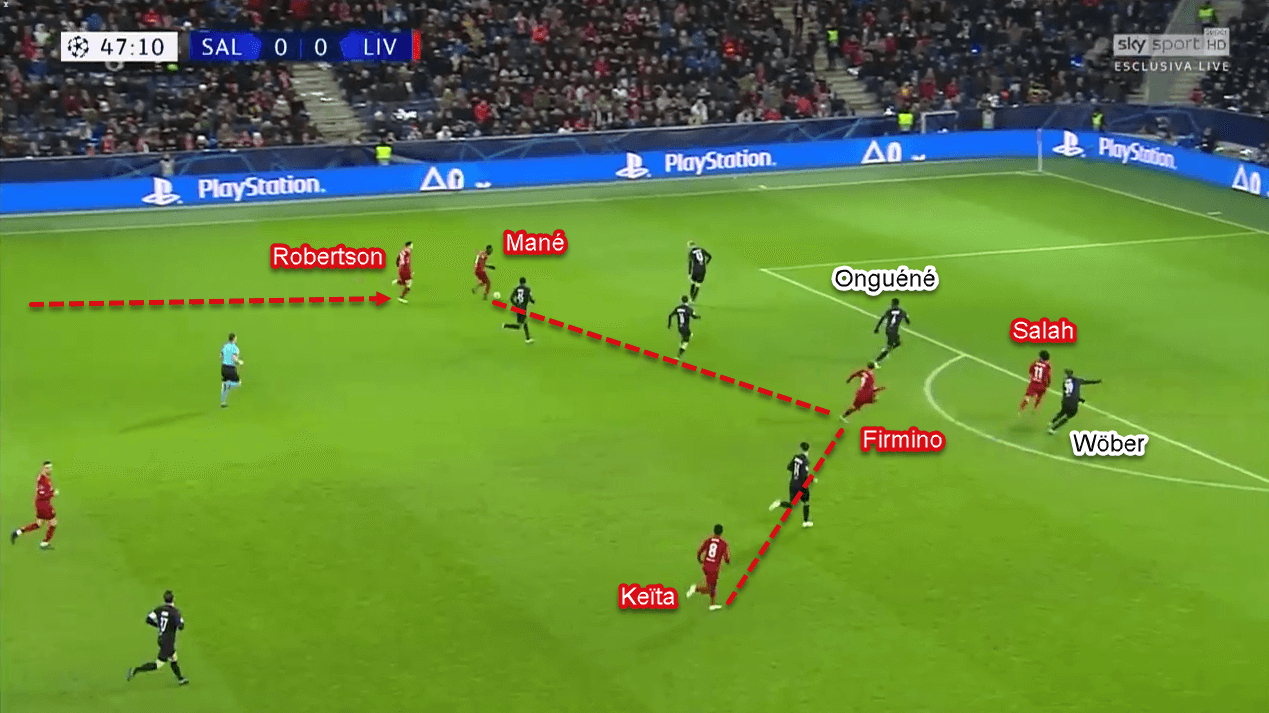
In the process, he put Salah as the main striker with Firmino behind him. Keïta then moved to the right flank while Mané stayed in his position. This 4–2–3–1 gave Liverpool more presence in wide areas – now with a total of four players. The two midfielders then had no attacking duties whatsoever, providing more defensive solidity and giving the full-backs more freedom to attack. This additional number in the flank was the main reason behind Keïta’s goal.
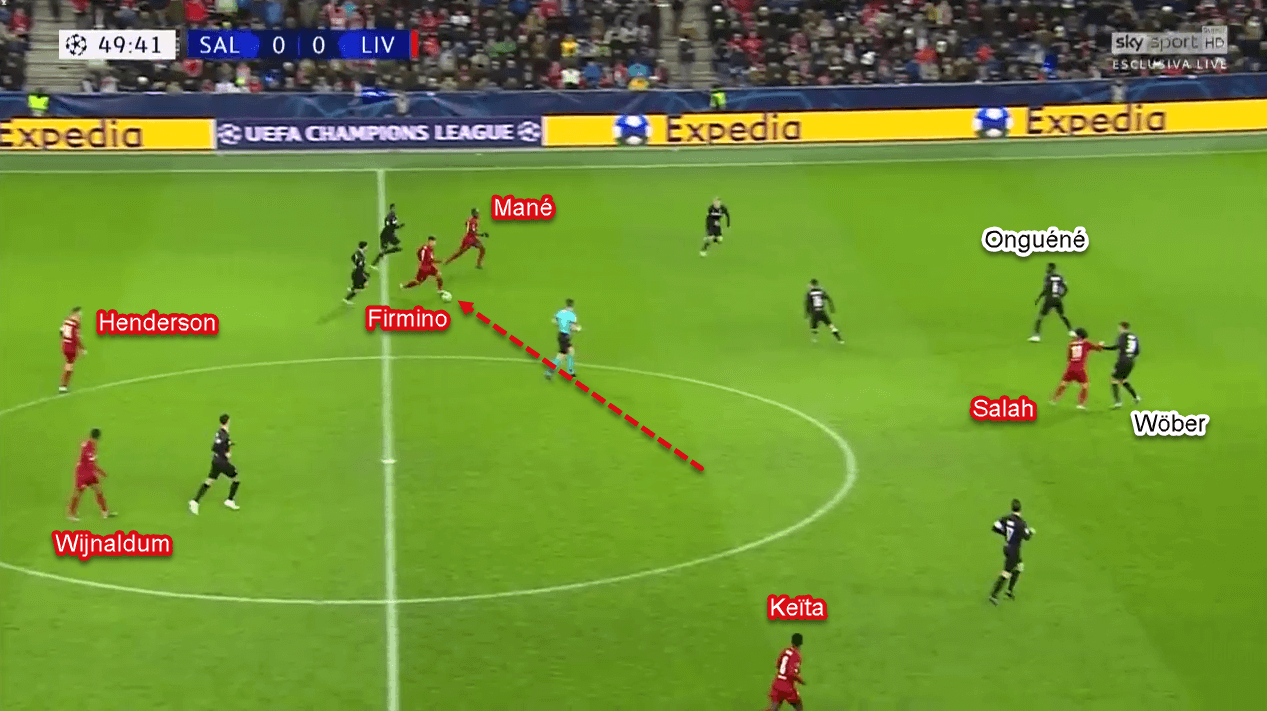
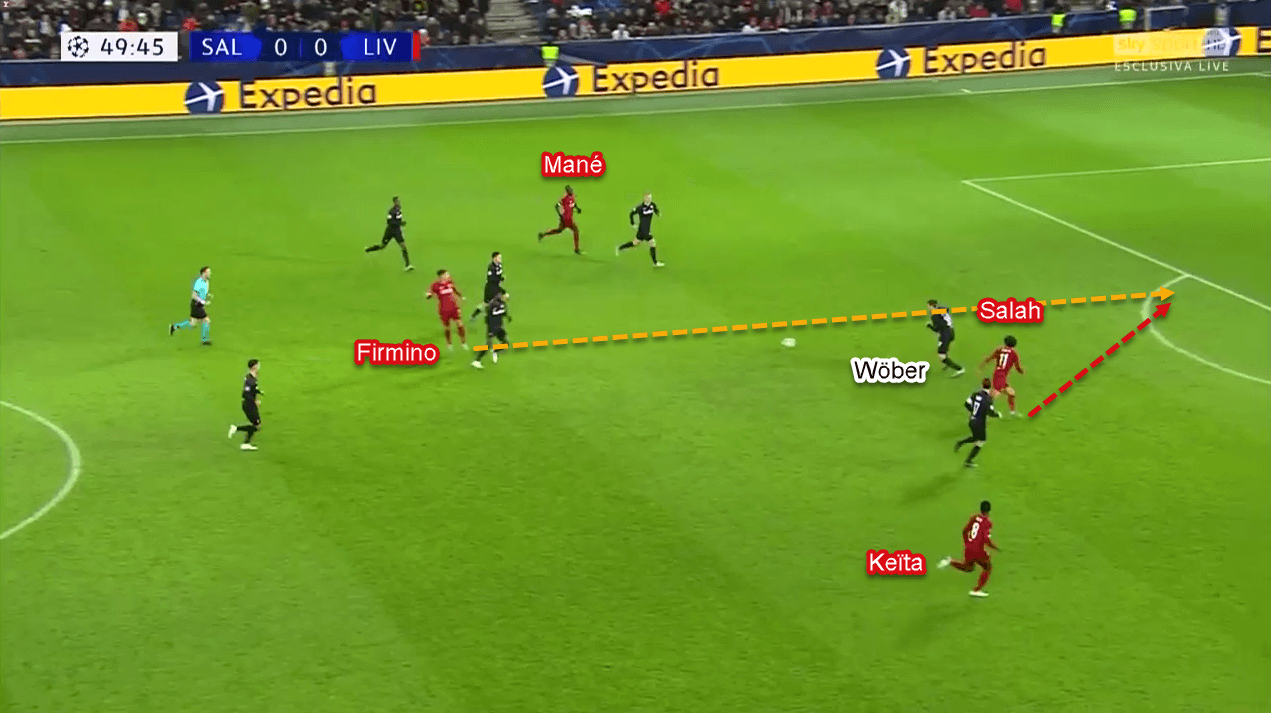
In the frontline, Salah was given a new role. As a striker, he was tasked to pin himself to the backline with less defensive duties. Behind him, the midfielders would serve him with through balls in behind: either grounded or aerial. By positioning himself in line with the defenders, Salah could utilise his pace more effectively. The reason was that the defenders would be unlikely to react quick enough – especially if Salah made his run from the defender’s blind-spot.
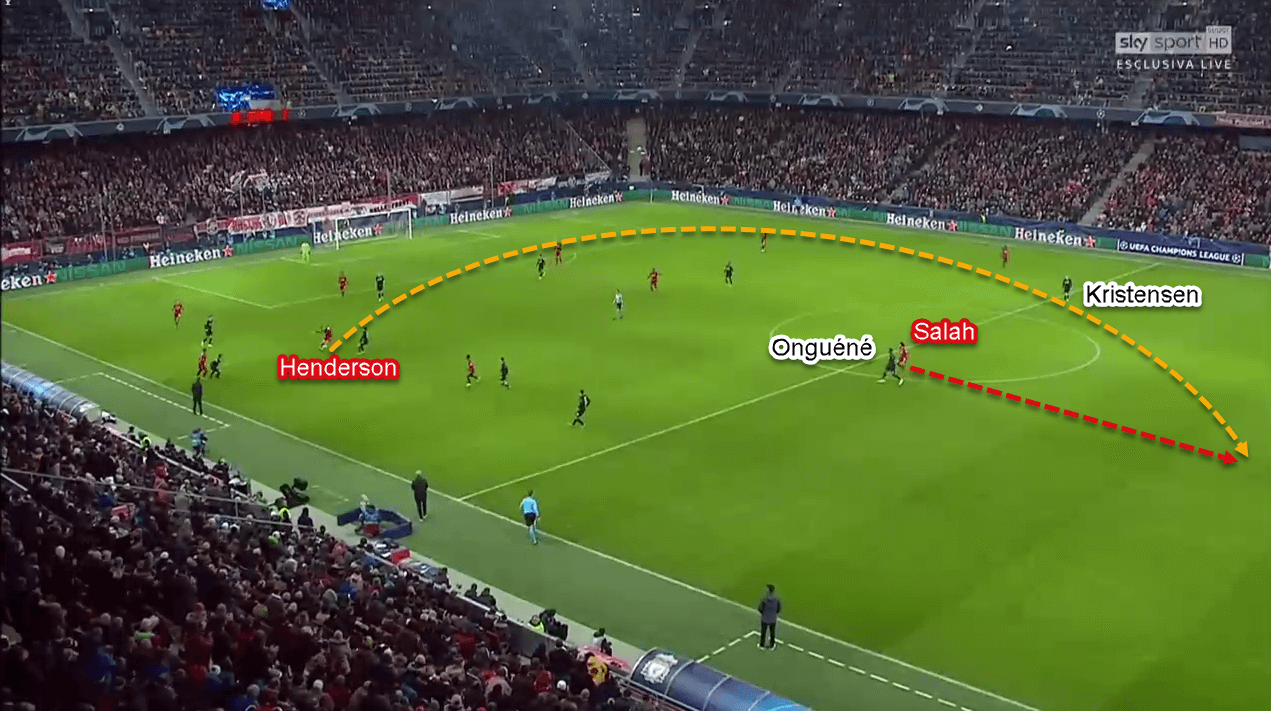
Conclusion
It seems like Marsch had no answer to Klopp’s game plan. As interesting as his side may be, the American manager needs to improve and add more to his creativity.
In the opposite side, Klopp’s smart tactics and his players’ quality in tight spaces were the reason why Liverpool should have scored more. To be honest, Liverpool were unlucky not to score in the first half, courtesy of Salah’s multiple misses. Nevertheless, his second-half adjustments proved his worth as one of the best tacticians in this planet.
One thing for sure, it’s going to be very interesting to see how both teams will fare in the knockout stage of their respective tournaments.

If you love tactical analysis, then you’ll love the digital magazines from totalfootballanalysis.com – a guaranteed 100+ pages of pure tactical analysis covering topics from the Premier League, Serie A, La Liga, Bundesliga and many, many more. Buy your copy of the December issue for just ₤4.99 here





Comments